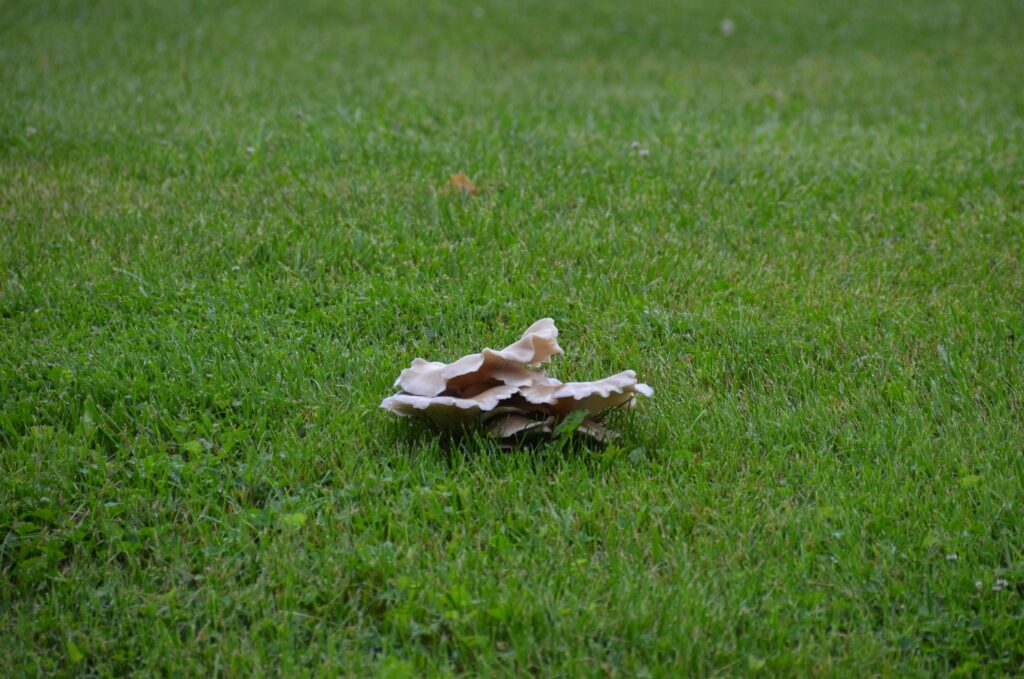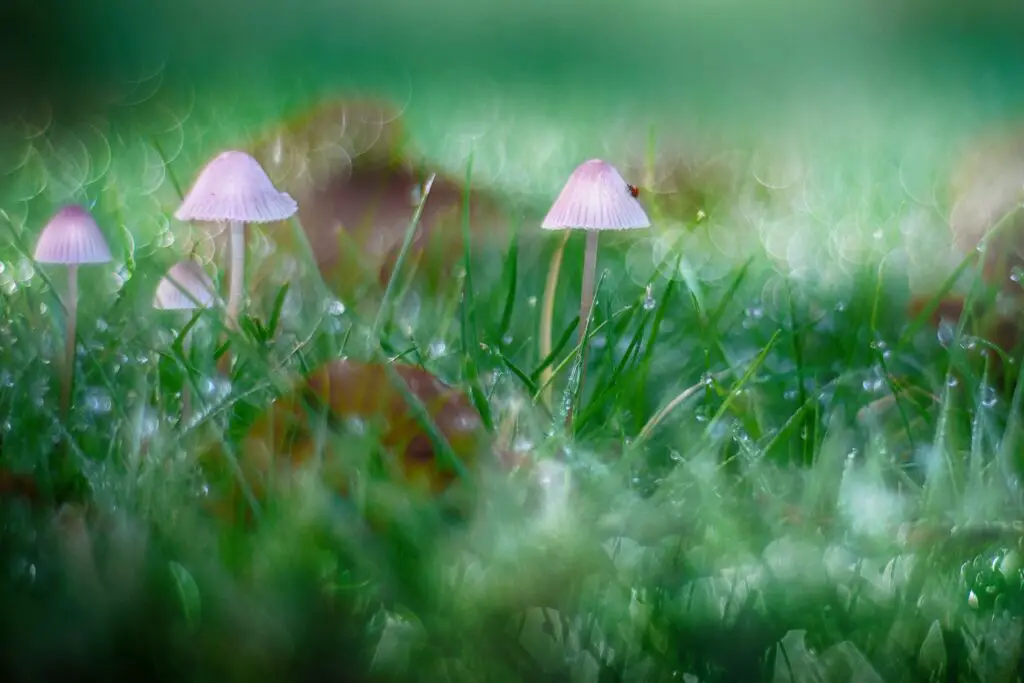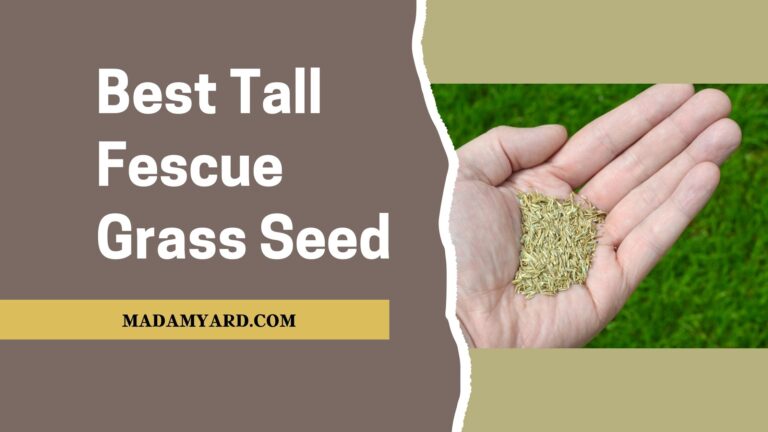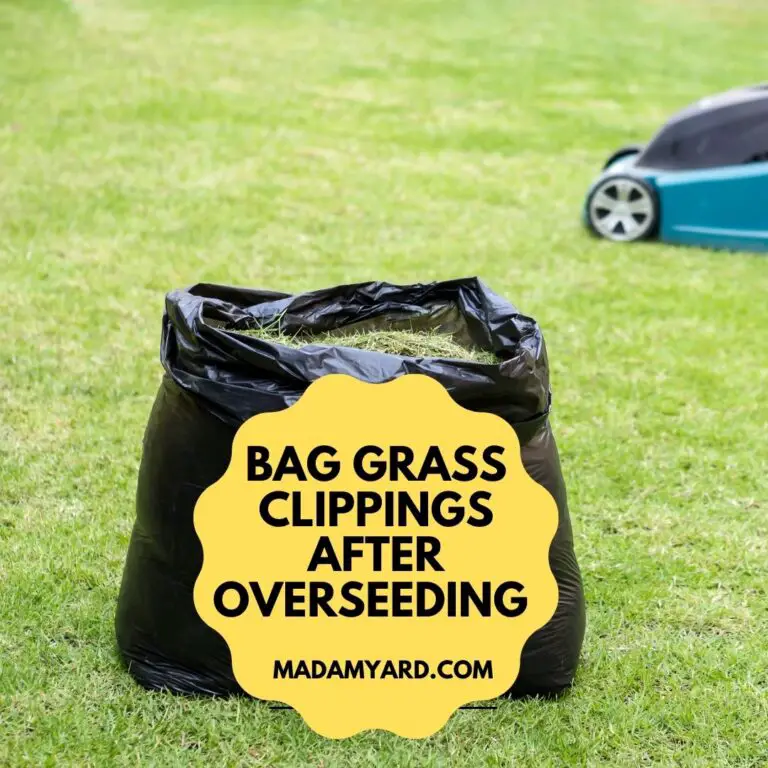How To Get Rid Of Mushrooms In The Lawn?
Mushrooms are fascinating, but growing them in your yard isn’t so much fun. Sorry, I couldn’t help myself! Mushrooms may be an eyesore on a lawn that is otherwise lush and green. It might be complex to figure out how to get rid of mushrooms in the lawn since they cause by something happening under the soil surface. Fortunately, mushrooms are usually safe, and most varieties of grass fungus do not cause disease.
They can, however, be harmful to children and pets in some situations, so you should remove them or at the very least examine their toxicity before accepting their presence in your yard.
The umbrella-shaped mushroom is the most well-known, but other mushrooms resemble fingers, jelly, bird nests, and puffballs, to mention a few.
Mushrooms can be a sensory overload; some scents attract flies.
There are so many different kinds of mushrooms that some individuals devote their entire lives to learning about them.

Why Do Mushrooms Grow In Lawns?
Mushrooms are fungi, as you are surely aware. We usually think of them as a form of toadstool with a cap, stem, and gills beneath the cap, but they can also be various types of fungus.
Mushrooms like wet, dingy environments with plenty of decaying matter to flourish in. However, you must not mistake grass mushrooms with the kind of mushrooms we eat since this can be dangerous or, at the very least nauseous.
Mushroom Ecology
Mushrooms aid in the breakdown of organic matter in the soil and converting that organic matter into nutrients that your grass can utilize. So, if you see mushrooms, organic matter is decomposing, and the soil is rich and healthy. They do, however, play an essential role in converting organic matter into more useable forms of nutrition for other plants.
Animal feces, dead grass, dead leaves, and even limbs and old rotting tree trunks, as well as underground roots, are all familiar sights in a yard. These are all great sources of food for mushrooms, which degrade into nutrients that other plants may utilize.
Yards with poor drainage and gloomy lawns are ideal for mushrooms to grow. Grass with a lot of thatch has a lot of organic stuff, which mushrooms may eat.
Then there are yards with animals like dogs, cats, chickens, or goats, whose excrement supplies organic matter perfect for mushroom sprouting.
Are Mushrooms In My Backyard A Bad Thing?

The good news is that, for the most part, sprouting mushrooms in your yard are safe, and it may even be a sign that your lawn is healthy and the soil is nutrient-rich!
In practice, if the mushrooms aren’t damaging anything, you may leave them in your yard, and they’ll break down and disintegrate after a few days. They aren’t harmful to your grass, and if anything, they improve the health of your lawn.
However, you may wish to remove mushrooms from your yard for cultural purposes. You may not need a group of mushrooms destroying your grass if you take pride in a lush, green, and uniform lawn. Mushrooms may eradicate from your yard if this is the case.
Aside from appearances, getting rid of mushrooms in your yard is a good idea if you have dogs or small children who could spot the mushrooms and try to eat them.
Some garden mushrooms are edible, but eating a mushroom is extremely unsafe and harmful if you don’t know what type. If you’re concerned that your children or dogs could try to eat the mushrooms, get rid of them! It’s best to be safe than apologies!
How To Get Rid Of Mushrooms In The Yard?
The key to efficiently eradicating mushrooms is to address the source of the problem. Even if removing a grass mushroom head from the surface is required, it will not prevent the mushroom problem from returning.
The battle against mushrooms in your yard must be comprehensive, encompassing proper yard management methods, to be effective.
1. Change The Growing Conditions In Your Yard
Mushrooms thrive in low light and plenty of moisture. You have a greater chance of avoiding mushrooms from growing in the first place if you can adjust the layout of your yard. Stop overwatering your lawn and trim away any excess vegetation to maintain it dark.
2. Remove Debris
Get rid of any decaying wood, leaves, or other organic debris in your yard. If you keep any form of rotting waste out of your yard, your chances of seeing mushrooms will drastically decrease.
You’re effectively depriving them of the nutrients they require to thrive. Clear organic material with a rake and leaf blower regularly, or pay a lawn care provider to do it for you.
3. A Sprinkle Of Nitrogen Fertilizer On Mushrooms
The best technique for getting rid of mushrooms on the lawn is to use nitrogen or urea. To do this, take some urea or nitrogen fertilizer and apply it in a sufficient amount based on the size of your grass.
If the mushroom has mushroomed all over the grass, spread the urea on it; if it has mushroomed in a specific area, erect a wall and sprinkle some urea on it.
Because urea and NH3 aid to destroy seed roots germination with the hydrolyzed toxin, this urea and nitrogen upset his beneath spores roots, decay, and burn his roots day by day. Consequently, this is the best way to remove mushrooms on your lawn.
4. Home Detergent With Soap/Soda And Water
Another simple method for getting rid of mushrooms on the grass is to use household soap or detergent mixed with hot water. So you grab your irrigation can and any detergent or soap you’ve been using.
So, if any of them favor soda or soap, mix 1/2 or 1/4 cup spoon with 2 liters water and pour from the top; you won’t have to worry about their returning.
It is the most basic method for eliminating mushrooms, and it is something you do twice a week.
To use detergent, use any household or dish detergent and combine 2 to 4 spoons of liquid detergent in 2 gallons of water or any bucket before pouring the mixture over the mushrooms.
Because most washing detergents contain sulfate, which helps stop the fungus from forming, this detergent combination helps you pierce or pierce down to organic matter and cancel or deny as soon as possible.
It would be best if you did this five times a month to get rid of mushrooms on a lawn in a cost-effective manner.
5. Keep Things Well Aired
Improving airflow as much as feasible is beneficial. It will cause the soil to dry up faster, making it less appealing to fungus. It can aid by removing any thatch.
Shorter grass can also discourage mushroom development, so mowing often is another option. Obviously, before cutting the grass, you should eliminate any mushrooms; otherwise, you risk spreading the problem even further.
6. Water Less/Improve Drainage
Because fungi grow in damp, shady environments, it’s a good idea to water your grass less regularly and only during daylight hours, especially in the morning. It reduces the chances of wet and dark coming into touch, ideal circumstances for mushrooms to flourish.
Irrigation is also essential, especially if you’ve had a lot of rain recently.
The goal is to maintain moisture in the air as low as possible.
7. Encourage Sunlight

Mushrooms prefer dark, moist grass areas, and thus too much shadow promotes their development. Pruning bigger trees and bushes to allow more sunshine into your grass area will help solve this problem. You can prune tiny trees just enough to make a difference, but a professional should trim bigger trees.
8. Dig Up Big Mushroom Clusters
Scoop up any soil where mushrooms are growing and remove any buried wood, huge tree roots, or other decaying items that might feed the fungi. At building sites, scraps of timber are occasionally buried, providing food for mushrooms.
Remember to remove the roots of any shrubs or trees you cut down in your yard to avoid further mushroom development.
9. Add French Drains To Heavy Mushroom Areas
Your lawn may be excessively damp, and mushrooms are attracted to dampness and decomposing matter. Even if the rotting stuff has been removed, the grass may still need to be dried off.
Double-check that the soil isn’t too wet before installing french drains. Look for rushes and other grasses that thrive in wetter conditions. If any of these are present, it makes sense to increase Drainage; otherwise, your grass may dry out.
10. Using Fungicide To Kill Mushrooms In Your Lawn
It’s important to note that fungicides aren’t effective in these instances, and it is counter to what many fungicide firms would tell you, yet it is true.
Fungicides will not solve the problem that is causing mushrooms to develop in your yard since they do not fit snuggly enough into the soil to reach the hyphae.
Although the surface mushrooms may die, guess who’ll be back at the store in a week or two to acquire more Fungicide?
Fungicides for lawns are designed to kill fungi that live for a short time, such as leaf mold or root rot.
Fungicides, despite their name, do not truly kill fungus. Instead, they function by covering the existing fungus and blocking its spores from spreading.
In this approach, a fungicide can help control the problem until the fungus reaches the end of its life cycle and dies.
Most pesticides or fungicides advertised expressly for killing mushrooms are now prohibited, so the holistic measures I’ve discussed above are your best chance.
Conclusion on How To Get Rid Of Mushrooms In The Lawn
There are chemical and natural fungal killers available to solve the riddle for “how to get rid of mushrooms in a lawn.” Vinegar and baking soda are chemical treatments, while physical removal and let the mushrooms run out of nutrients are organic methods. The second option is always preferable since it has no detrimental impact on the land.
If you have the time and patience, manually uprooting mushrooms or allowing them to run out of nutrients is the best approach to get rid of them. They won’t survive for long if there isn’t enough wet stuff for them to eat. This way, after the mushrooms are gone, your lawn toadstools will still be there.







